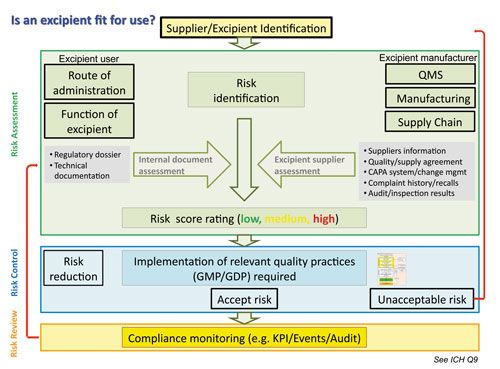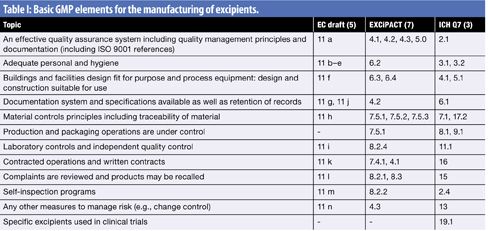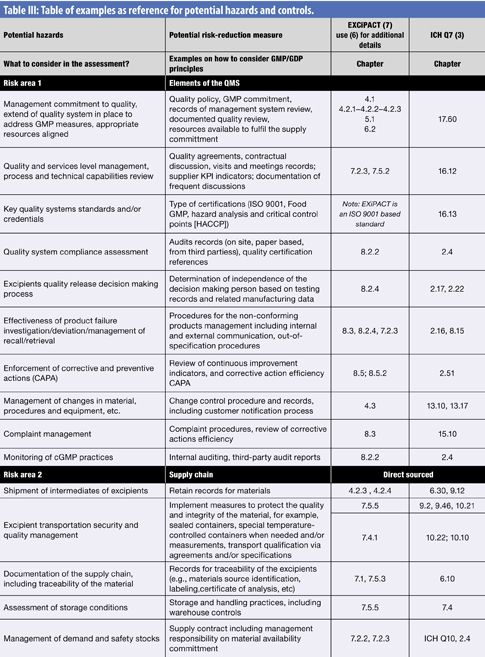A Practical Approach of Implementing GMP for Excipients
Using a model quality risk-management process according to ICH Q9, the authors discuss ways to apply this guideline.

The recent European Union Falsified Medicine Directive highlights the call for a secured supply chain for medicines. After years of legal debates on ways to address excipients control in Europe, the manufacturing authorization holder is finally accountable to develop a process along the principles of the International Conference on Harmonization on
Quality Risk Management
(ICH Q9) to assess the suitability of the quality and safety of the excipients used. A guideline on a potential formalized risk-management process for ascertaining the appropriate GMP for excipients is expected to be published by the European Commission soon and should provide direction on the level of GMP to be expected for these materials. Using a model risk-management process proposed by industry, the authors discuss ways to apply this requirement, suggesting a strong emphasis on the nature of the “excipients industry” and the need for a close collaboration between the supplier and user prior to setting up any risk control strategy at the supplier manufacturing premises. The International Pharmaceutical Excipients Council (IPEC) and the Pharmaceutical Quality Group (PQG) GMP and IPEC GDP guidelines, as well as similar recognized GMPs and/or quality system standards, are used as a guide to implement the detailed practices.
Background
In the EU, binding definitions are in place for medicinal products (1) and APIs (2, 3). It is an ongoing process to develop appropriate requirements for pharmaceutical excipients, which represent up to more than 90% of dosage forms.
A series of tragic incidents in the pharmaceutical supply chain caused the European Commission to propose an application of GMP for APIs (3) as guidance for the manufacturing of “potentially” critical excipients in 2007. The assessment report of this public consultation concluded that pharmaceutical companies defining the appropriate GMP for excipients, based on risk, would result in a more pragmatic approach. As a result, the European Commission adapted the legal basis for defining the appropriate GMP for pharmaceutical excipients using a risk-based approach: “The holder of the manufacturing authorization shall ensure that the excipients are suitable for use in medicinal products by ascertaining the appropriate good manufacturing practice on the basis of a formalized risk assessment” (4). A draft on Guidelines on the Formalized Risk Assessment for Ascertaining the Appropriate Good Manufacturing Practice for Excipients of Medicinal Products for Human Use (5) was submitted for public consultation.
The risk-assessment model proposed and discussed in this article refers to these expectations (5). It also takes into account and provides links to existing guidance developed by industry and experts such as IPEC/PQG (6) and EXCiPACT (7), which are based on ISO 9001 and ICH Q7 (3).
Points for consideration on an appropriate GMP for excipients
Before excipient manufacturers are able to address implementation of an appropriate GMP for excipients, it has to be recognized that excipients are starting materials for medicinal products, which have not necessarily been designed exclusively to be used for medicinal purposes. Although accepted as safe to use in other consumer industries (e.g., food, cosmetics), the type of good practices in manufacturing may differ based upon design and practice by the company and technology used. This raises the essential need for a good interaction and communication between excipient manufacturers/distributors and users. Assessment of the appropriate formal level of GMP and GDP will have to be considered by both parties in a collaborative manner.
The user will have to determine the type of risks associated with their product, share the excipient functioning role, and communicate with the supplier/distributor potential critical quality attributes, which might impact its risk assessment. This kind of assessment may already occur today, although in most cases, informally. A good base for the primary assessment of the supplier (e.g., regulatory files, specifications, questionnaires results, audit reports) is complemented by transparency of available data from the user’s side. An appropriate form of agreement is typically required to address a supplier’s legitimate concerns in sharing its confidential information.
On the other hand, the excipient manufacturer should be able to obtain sufficient information on the potential end use of his excipient too, and only then assess his ability to meet GMP and/or GDP expectations. Information known to the user through its own supplier qualification scheme should allow him to initiate a risk assessment. This information that is known by the user, which will allow him to conduct its risk analysis, is usually reflected in a quality agreement or questionnaire, targeting the understanding of key elements on quality systems and GMP, such as change management, corrective and preventive action (CAPA), auditing, or third parties’ assessments.
Risk assessment for critical drug applications cannot occur without an appropriate dialogue between user and excipient supplier. Ignoring this essential step may lead to an inaccurate representation of the risks associated with manufacturing and supply of the material, and rank the risk/application/supply source inappropriately.
Assessing the risks through a proper user/supplier dialogue should allow better control of risks at relevant places during manufacturing and supply, resulting in a more effective risk reduction. Excipient suppliers may reasonably seek to limit their liability so that controls in a quality agreement mitigate risk without shifting it entirely to the supplier. Depending on the outcome of that assessment, certain sources of supplies may be seen as unacceptable. Actions are potentially to be taken to reduce identified risks. Such an approach should allow developing and documenting the relevant expectations for quality practices and the appropriate level of GMP/GDP.
It is, therefore, generally best practice for the user to develop, assess, and document the right key performance indicators (KPIs) to monitor the excipients quality in conjunction with the respective supplier according to the proposed overall risk-assessment model (see Figure 1).

A potential implementation of a risk-based approach
GMP references for risk assessment. Excipients are regulated as starting materials for drug (medicinal) products. At this moment, the only GMP for starting materials, which is legally binding, is the ICH Q7 GMP guideline (3) for the manufacturing and distribution of APIs.
It can be argued that it may be neither adequate or appropriate to use ICH Q7 (3) requirements to define the GMP for excipients due to their complex nature. Guidelines developed by industry, such as IPEC/PQG GMP (6), IPEC GDP (8), and EXCiPACT (7), or equivalent guidance, provide appropriate quality systems and GMP standards reference. They are based on ISO 9001 quality systems concepts and provide an excellent foundation for the GMP and GDP gap assessment. The authors think that these guidelines provide a sufficient basis and no additional “what to do” nor a “how to do” guidance would be needed (see Tables I and II).


Quality risk-management principles as enabler. To comply with the expectation of implementing an appropriate “GMP for excipients” standard, the principles on quality risk management per ICH Q9 (9) can be used by the manufacturing authorization holder (MAH) as a reference to support the formal risk assessment of their excipient manufacturers/distributors. Excipient users, certification organizations, and regulators could use similar risk-assessment models when auditing excipient manufacturers.
As foundation of such a risk assessment and to determine the appropriate level of GMP and/or GDP for excipients, it is necessary to follow and keep in mind the two primary principles issued by ICH Q9 (9):
- The evaluation of the risk to quality could be based on scientific knowledge and ultimately link to the protection of the patient
- The level of effort, formality, and documentation of the quality risk-management process could be commensurate with the level of risk.
Understanding risk as “the combination of the probability of occurrence of harm and the severity of that harm” per ICH Q9 (9) is essential. Nevertheless, a list of hazards should not necessarily drive excipient users and/or regulators to potentially implement risk control measures for each and every hazard identified. All discussions and considerations should be linked back to risk levels (i.e., a combination of severity, probability, and detectability) with the main focus on the protection of patients.
Applying a risk-based approach, similar to the one described in ICH Q9, could be used to determine the level of good manufacturing and distribution practices (GMDPs) for excipients (see Figure 2). This process could be implemented retrospectively for currently used excipients, as well as prospectively during pharmaceutical development.

Typical quality areas to consider for the risk assessment
In the context of manufacturing of excipients, five specific areas of potential risks should be considered, understood, and assessed when reviewing the excipient manufacturers’ quality management system, as applicable.
Assessing the quality management system (QMS). Many excipient manufacturers have already implemented a certified QMS according to ISO 9001 requirements, or similar quality systems. These basic principles (including management responsibility, management of resources, requirements for product realization, and concepts on measurement, analysis, and improvement) represent basic expectations for a QMS for pharmaceutical manufacturing purposes.
Assessing the supply chain. Another key source of risk is the complexity of the excipient supply chain, which may include different actors prior to reaching the user of the excipient. Considering the origin of the material is potentially critical, whether it is directly sourced from the producer or indirectly sourced throught a third party. Additionally, repackaging and relabeling operations are regarded as “manufacturing” activities and should also be performed under an appropriate GMP.
Assessing the manufacturing of the excipient. Several factors could be considered, based on the source of the raw materials, the manufacturing process type, the equipment used, and the site organization. Facility and layout of the manufacturing site are unlikely to be similar to the ones used by pharmaceutical industry. A pragmatic approach has to be taken when identifying hazards associated with the supply of these materials. Use of risk assessment may be already a standard practice in some organizations (e.g., hazard analysis and critical control points [HACCP], failure modes and effects analysis [FMEA], etc.), and could be used and/or referenced for other specific risk-assessment purposes.
Assessing the route of administration in the drug product. It is important to seek a dialog with the excipient users, if possible, to generate an understanding for the particular needs of the respective drug product. Often such discussions are limited or prevented for reasons of confidentiality. However, it is regarded as very useful to provide the excipient manufacturer with a basic understanding of its excipient use, especially when higher risk applications are foreseeable (e.g., in sterile products).
Assessing the function of the excipient. Specific consideration should be given to the influence on bioavailability and the manufacturing process of the drug product, if known. This is particularly important if an enhanced development approach (based on quality by design) has been taken, for example, to assess the excipient’s impact on the drug product’s critical quality parameters.
Each of these key elements should to be considered during the risk assessment (see also information and references in Table III). Should any of these hazards raise a specific risk flag, risk reduction measures could be considered during the risk control phase as a basis for an appropriate risk acceptance decision. The risk-management process should be completed by monitoring and reviewing quality indicators (e.g., KPIs) and CAPA measures from internal and/or external audits.


Appropriate control elements might be already implemented by the excipient manufacturer; for example, they may use different terminologies or processes to achieve the expected risk control measures. These elements are essential and justify the discussion between excipient manufacturer and user.
Potential considerations to GMP for excipientsTables I and II provide reference lists and link to similar basic GMP elements for the manufacturing of excipients as described in the European Commission draft guideline (5), EXCiPACT (7), and ICH Q7 (3). The authors consider it helpful to review these tables as part of the risk analysis, taking into account the principles of quality risk management based on ICH Q9 (9) to fulfill upcoming expectations and requirements. Similar basic GDP requirements apply to most excipient distribution operations as well as potential national legislation on distribution of goods under the trade applicable law.
More details (see Table III) could be considered as a potential source of examples during the risk assessment of the typical quality area mentioned in the previous section on typical quality areas to consider for the risk assessment.
Conclusion
Formal requirements for GMP for excipients are developing in the European Union and beyond, such as the US and China. For example, in the US, FDA has initiated the Secure Supply Chain Pilot Program to enhance the security of imported drugs through effective controls over drugs from the time of manufacture abroad through to entry into the US (10). The development and implementation of such regulations will need a strong harmonization effort including communication and collaboration between all parties to be successful. These requirements should build on existing recognized practices that have already been demonstrated to be sufficient in most cases. Although quality management systems applied by excipient manufacturers often appear to be different from those used by pharmaceutical industry, it is expected that a risk-based approach focusing on the risk to patients will allow the implementation of pertinent elements of GMPs as necessary.
Acknowledgements
This article is based on discussions that the authors have had with teams of subject matter experts in the International Pharmaceutical Excipients Council (IPEC) Europe, Pharmaceutical Quality Group (PQG), and the European Federation of Pharmaceutical Industries and Associations (EFPIA). The authors would like to thank these groups for their valuable input.
References
1. EU Directive, 2003/94/EC, Principles and guidelines of good manufacturing practice in respect of medicinal products for human use and investigational medicinal products for human use (Brussels, Oct. 08, 2003).
2. EU Directive, 2001/83/EC, Community code relation to medicinal products for human use (Brussels, June 25, 2003).
3. ICH, Q7 Good Manufacturing Practice for Active Pharmaceutical Ingredients, Step 4 version (November 2000).
4. EU Directive, 2011/62/EU, amending EU Directive 2001/83/EC, Medicinal products for human use, with regards to the prevention of the entry into the legal supply chain of falsified medicinal products (Brussels, June 08, 2011).
5. European Commission, SANCO/D/6/SF/mg/ddg1.d.6(2013)179263, Guideline of the formalized risk assessment for ascertaining the appropriate good manufacturing practice for excipients of medicinal products for human use, draft submitted for public consultation (Brussels, Feb. 06, 2013).
6. IPEC/PQG, The joint IPEC-PQC Good Manufacturing Practice Guideline for Pharmaceutical Excipients (2006), accessed Aug. 8, 2014.
7. EXCiPACT, Certification Standards for Pharmaceutical Excipient Suppliers: Good Manufacturing Practice, Good Distribution Practice (2006), accessed Aug. 8, 2014.
8. IPEC, The IPEC Good Distribution Practice Guideline for Pharmaceutical Excipients (2006), accessed Aug. 8, 2014.
9. ICH, Q9 Quality Risk Management, Step 4 version (November 2005).
10. FDA, FDA initiates the Secure Supply Chain Pilot Program to enhance security of imported drugs, accessed Aug. 8, 2014. PT
About the Authors
Patricia Rafidison is global regulatory affairs and compliance manager at Dow Corning, p.rafidison@dowcorning.com
Frithjof Holtz is head of advocacy/surveillance Merck Millipore at Merck KGaA
Stephan Rönninger is head of external affairs Europe, International Quality at Amgen (Europe) GmbH.
